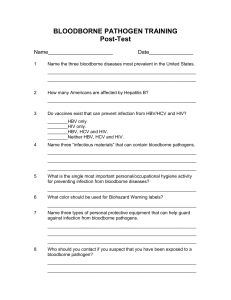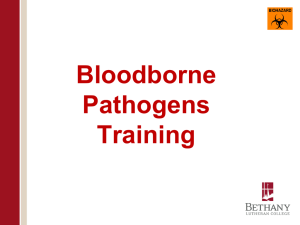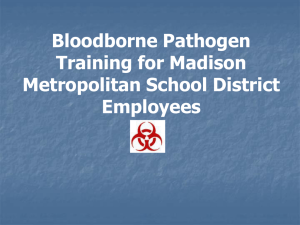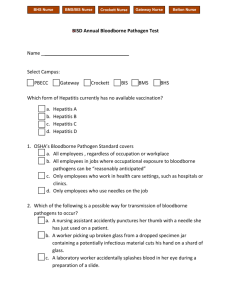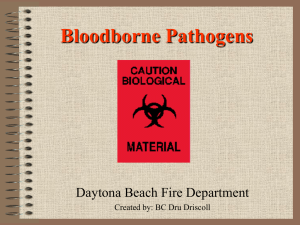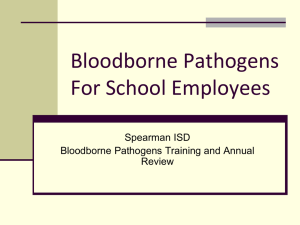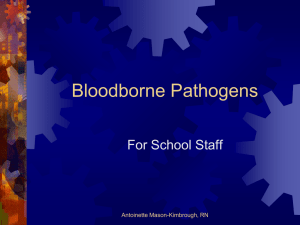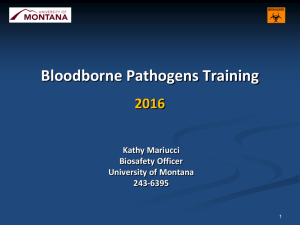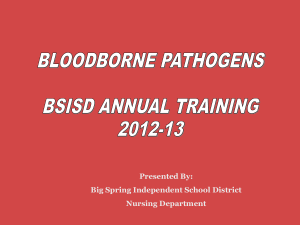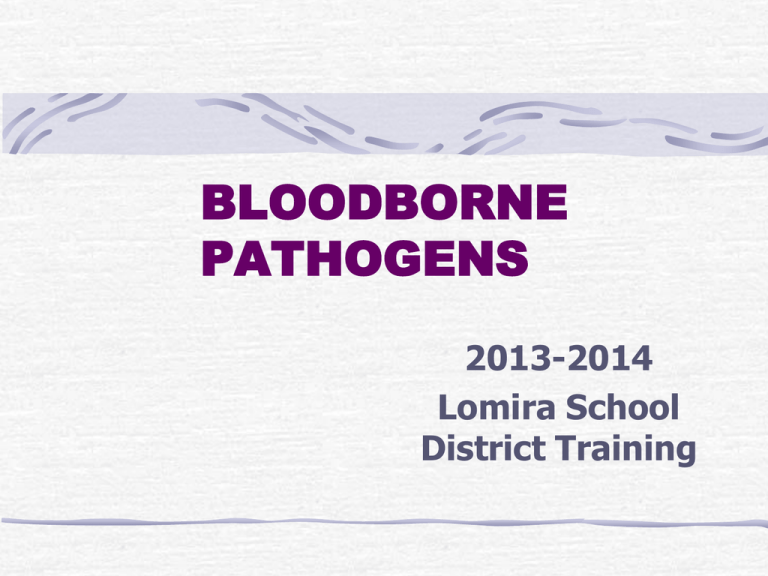
BLOODBORNE
PATHOGENS
2013-2014
Lomira School
District Training
INTRODUCTION
Thank you for fulfilling your annual
bloodborne pathogen training obligation.
Please review each slide and, when finished,
print the quiz located on the district website.
After completing the quiz, please turn it into
your school secretary or Jess Gassner, school
nurse, by September 13th.
THE BLOODBORNE PATHOGEN
STANDARD
Federal law 29 CFR 1910.1030 sets forth the
law employers must follow as part of a
comprehensive effort to control the spread of
bloodborne pathogens.
As part of that standard, the district is
required to offer annual trainings on
bloodborne pathogens and reducing the risk
of contamination.
BLOODBORNE PATHOGENS
The most three most deadly bloodborne
pathogens are:
Hepatitis B (HBV)
Hepatitis C (HCV)
Human Immuno
Deficiency Virus (HIV)
HEPATITIS B (HBV)
Causes serious liver disease
50% of people infected with HBV have no
symptoms
Symptoms include jaundice, fatigue, loss of
appetite, abdominal pain, occasional nausea
or vomiting
Most HBV sufferers recover, however, 10%
retain the disease for life
HBV causes 5,000 deaths per year
HEPATITIS B VACCINE
A vaccination is available for
Hepatitis B in a series of three
shots
As a Lomira School District
employee, you can request the
Hepatitis B vaccination by
contacting the district office if
you do not already have the
vaccination
HEPATITIS C (HCV)
Causes a serious liver disease known as Hepatitis C
Viral Infection.
May cause symptoms similar to Hepatitis B
85% infected with HCV have chronic infections
3 Million in U.S. are chronically infected with HCV
Many people show no symptoms
This is the leading cause of liver transplants
Up to 10,000 die annually from HCV
There is currently no vaccine to prevent HCV
HUMAN IMMUNO
DEFICIENCY VIRUS (HIV)
Attacks person’s immune system and causes it to
lose its ability to fight infection
Some infected persons may go on to develop AIDS
(Acquired Immno Deficiency Syndrome)
There is no preventative vaccine for HIV
TRANSMISSION
Spread most easily through contact with blood,
semen, vaginal secretions and any other body fluids
and tissue with visible blood
Occurs most frequently from needles and
unprotected sex
At work, the diseases are
spread by blood entering your
body through cuts, punctures,
or splashing that enters the
mucous membranes of the
eyes, nose or mouth.
PROTECTION
The bottom line - treat blood, all body fluids,
excretions, secretions, non-intact skin, mucous
membranes as though infected with bloodborne or
other pathogens
PERSONAL PROTECTIVE EQUIPMENT
(PPE) or Universal Precautions
Gloves
Gowns
Aprons
Lab Coats
Face Shields
Protective Eyewear
Masks
Mouthpieces
Resuscitation Bags
PERSONAL PROTECTIVE
EQUIPMENT (PPE) (continued)
If you need rubber gloves for your classroom, please
contact Jess Gassner, school nurse.
If the PPE is damaged or does not fit, please do not
use the item.
If the PPE is penetrated by blood or body fluid,
remove the item and properly dispose of it by
contacting the maintenance department.
You must wear gloves whenever contact with a
potentially infectious material is possible
PERSONAL PROTECTIVE
EQUIPMENT (PPE) (continued)
Gloves can be torn or punctures
so cover hand cuts or skin
abrasions with bandages before
school
Replace disposable single use
gloves as soon as possible if
contaminated, torn, punctured
or no longer effective – NEVER
RE-USE THEM.
PERSONAL PROTECTIVE
EQUIPMENT (PPE) (continued)
While both hands are gloved, carefully peel one glove
off from the wrist to the fingertips – then hold it in
the gloved hand – with the exposed hand, peel the
2nd glove off the same way, tucking the 1st glove
inside the 2nd. Dispose of promptly and NEVER touch
the outside of a glove with your bare skin.
Always wash your hands with soap and running
water as soon as possible.
HANDWASHING
#1 protection against all
infections, including flu & colds!
Keeps you from infecting people or
other objects
Wash your hands after contacting
blood, body fluids, excretions or
secretions, even if you are wearing
gloves.
HANDWASHING 101
Wash hands with soap and running water for 10-15
seconds
Rub vigorously over all surfaces including above
your wrists
Rinse thoroughly and dry with clean paper towel
and discard
Using clean paper towel, turn off faucet
Anti-microbial soaps or cleaners should only be used
when indicated since they remove your skin’s
natural protective defenses
COMMON SENSE WORK
PRACTICES
You should not eat or drink where you are
likely to be exposed to blood or body
fluid.
NEVER keep food or drink in places where
blood or other potentially infected
materials are present.
Do not handle contact lenses or apply
cosmetics or lip balms where exposure is
possible
COMMON SENSE
WORK PRACTICES (continued)
Call maintenance to clean all blood and bodily fluid
spills promptly
Keep work surfaces and protective coverings clean
Wear gloves to handle contaminated materials
Be careful to prevent exposure of your clothing and
skin
COMMON SENSE
WORK PRACTICES (continued)
Trash may contain sharps or other
infectious material so do not push it
down with your hands or feet. Instead
gently shake down waste containers
and carry waste bags by the top away
from your body
Dispose of blood and other regulated
medical waste in appropriately labeled,
closeable, leak-proof containers
GOOD HOUSEKEEPING
(continued)
General rules:
Contact maintenance to clean and
decontaminate equipment and working
surfaces with appropriate disinfectants as
soon as possible after contact with
potentially infectious material
Use a broom and dustpan to pick up broken
glass, not your hands, or call a custodian
GOOD HOUSEKEEPING
(continued)
Put contaminated sharp materials and other potentially
infectious wastes in closeable containers labeled
“biohazard”
Sharp material should be placed in sharps containers,
not the trash
IF EXPOSED
Do not panic – Immediately wash exposed skin
area with soap and water
If infectious materials enter your eyes, flush eyes
with large amounts of clean water
Report exposure to the school nurse, secretary or
principal immediately so post-exposure evaluation
can begin
Exposure does not always lead to infection
PUTTING INTO PERSPECTIVE
For those who have not been vaccinated, the risks of
contracting a bloodborne infection after a sharps
injury are:
1 in 6 will acquire Hepatitis B
1 in 20 will acquire Hepatitis C
1 in 300 will acquire HIV
DISTRICT CONTACTS
If you have any questions
or concerns regarding
any of the material
presented, contact
either the school nurse
or Building Maintenance
Supervisor. Their
contact information is
included is as follows:
Jess Gassner,
School Nurse
x117
Dean Hartwig,
Building Maintenance
Supervisor
x119


